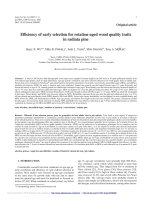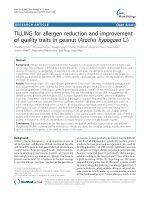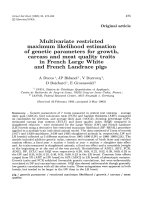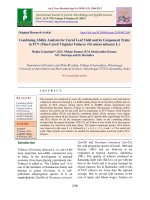Combining ability studies for fiber quality traits in desi cotton (Gossipium Arboreum L.)
Bạn đang xem bản rút gọn của tài liệu. Xem và tải ngay bản đầy đủ của tài liệu tại đây (235.47 KB, 7 trang )
Int.J.Curr.Microbiol.App.Sci (2019) 8(3): 415-421
International Journal of Current Microbiology and Applied Sciences
ISSN: 2319-7706 Volume 8 Number 03 (2019)
Journal homepage:
Original Research Article
/>
Combining Ability Studies for Fiber Quality Traits in
Desi Cotton (Gossipium Arboreum L.)
R. Divya Bandhavi1*, H.V. Kalpande1, Rashad Khan2 and Siddarth Panda2
1
Department of Agricultural Botany, Vasantrao Naik Marathwada Krishi Vidyapeeth,
Parbhani-431402, Maharashtra, India
2
Department of Plant Breeding and Genetics, OUAT, Bhubaneshwar, Odisha, India
*Corresponding author
ABSTRACT
Keywords
Cotton, Fiber
quality, GCA, SCA,
Line x tester
analysis
Article Info
Accepted:
07 February 2019
Available Online:
10 March 2019
Twenty four hybrid combinations derived by crossing six arboreum lines (PA 713, PA
743, PA 734, PA760, PA 720, PAIG 326) with four arboreum testers (PA 255, PA 402,
PA 08, PA 528) were tested along with their parents including two checks (PKVDH 1,
SWADESHI 651). The observations on five fiber quality traits were recorded on randomly
selected five plants. Among ten parental lines, four lines were found to be the best general
combiners. PA 760 and PA 255 showed good general combiner for 2.5 per cent span
length, PA 743, PA 734, PA 08, PA 255 showed good general combiner for fibre fineness
(micronaire) and PA 720 and PA 760 among females and PA 255 in males showed good
gca for short fibre index and fibre strength. Likewise PAIG 326 and PA 720 showed same
for uniformity ratio in desirable direction. The study of sca revealed that the cross PA 734
x PA 528 exhibited significant high sca effect for 2.5 per cent span length, fiber strength
and showed significant negative sca effect for short fibre index. Whereas the cross PA 760
x PA 402 exhibited positive significant sca effects for fibre strength and uniformity ratio.
Similarly the crosses PAIG 326 x PA 255 and PA 734 x PA 528 showed significant
negative sca effect for short fibre index.
Introduction
Cotton the „white gold‟ enjoys a pre-eminent
status among all cash crops in the country. It is
grown commercially in the temperate and
tropical regions of more than 70 countries.
Currently, Gossypium includes 50 species,
four of which are cultivated, 43 are wild
diploids and three are wild tetraploid. Out of
the four cultivated species, Gossypium
hirsutum L. and Gossypium barbadense L.,
commonly called as new world cottons are
tetraploids (2n = 4x = 52), whereas,
Gossypium herbaceum L. and Gossypium
arboreum L. are diploids (2n = 2x = 26) and
are commonly called as old world cottons. Out
of four cultivated species of genus Gossypium,
only two species i.e. G. hirsutum and G.
arboreum are being mostly cultivated in
Maharashtra. G. arboreum, also known as
Tree Cotton, together provide 2% of the
world‟s cotton. In the last few years there has
been a significant reduction in area of G.
arboreum cotton across the country and
415
Int.J.Curr.Microbiol.App.Sci (2019) 8(3): 415-421
particularly in Maharashtra because of lower
productivity and inferior fibre properties as
compared to tetraploid cotton in rainfed ecosystem and non availability of Bt variety /
hybrid. Genetic improvement in desi cotton
could be gain either through combination or
exploitation of hybrid vigour. Although,
Indian cottons have very wide quality
spectrum, the right combination of fibre
length, micronaire and fibre strength is
however absent in many of the popular
varieties and hybrids. The deficiency in
particularly discernable in the staple range of
27 to 30 mm combined with micronaire of 4.0
to 4.5 and a strength of 22 to 25 g per tex.
Indian cottons confirming to long and extra
long staple group are too fine coupled with
weak strength. There is an urgent need to
promote those cottons that could come closer
in quality to the most sought by modern textile
mills. The information on the nature and
magnitude of gene action is important in
understanding the genetic potential of
population and decide the breeding procedure
to be adopted in given population. Line x
tester analysis is a precise method for
obtaining such information when a large
number of parents to be tested.
Materials and Methods
The present investigation was undertaken to
study “combining ability studies for fiber
quality traits in desi cotton (Gossypium
arboreum L.)” in line x tester programme
involving twenty four hybrid combinations
derived by crossing six arboreum lines(PA
713, PA 743, PA 734, PA760, PA 720, PAIG
326) with four arboreum testers(PA 255, PA
402, PA 08, PA 528) were tested along with
their parents including 2 checks (PKVDH 1,
SWADESHI 651) at Cotton Research Station,
Mahboob Baugh farm, Vasantrao Naik
Marathwada Krishi Vidyapeeth, Parbhani
during kharif season of 2013-14. All the
parental material was planted during summer
2013. Two sets of parental lines were sown at
an interval of 8 days to ensure synchrony in
flowering and to complete hybridization
between selected parents. The line x tester (6 x
4) crossing was effected and total 24 crosses
along with ten parents and 2 checks were
grown in randomized block design with three
replications with spacing of 60cm X 30cm.
Observations were recorded on the following
fiber quality components2.5% span length
(mm), Micronaire/Fibre fineness (10-6 g/inch),
Fibre strength (g/tex), Uniformity ratio (%),
Short fiber index (%).
Results and Discussion
The cross PA 743 x PA 528 (1.92), PA 713 x
PA 528 (1.75) and PAIG 326 x PA 255 (1.72)
showed significant positive SCA effects for
2.5% span length. Out of 24 crosses the cross
PA 760 x PA 402 (2.19), PAIG 326 x PA 08
(1.29) and PA 713 x PA 528 (1.22) showed
significant positive SCA effects for fiber
strength. The cross PA 760 x PA 402 (2.08)
exhibited positive significant SCA effects for
uniformity ratio. For Short fibre index (%) Out
of twenty four crosses studied, six crosses
showed significant positive SCA effects and
five crosses exhibited negative significant
effects. The cross PAIG 326 x PA 528 (6.02)
followed by PAIG 326 x PA 402 (2.62)
showed maximum significant positive SCA
effects. While cross PAIG 326 x PA 255 (5.45) exhibited maximum significant negative
SCA effects, followed by PA 743 x PA 528 (3.58), PAIG 326 x PA 08 (-3.18), PA 760 x
PA 402 (-2.83) and PA 713 x PA 528 (-2.60)
(Table 3).
Analysis of variances due to gca (62 gca) were
relatively lower in magnitude as compared to
sca variances (62 sca) (Table 1). The ratio of
62 gca/ 62 sca was less than unity for most of
the characters indicating predominance of
non-additive gene action. These components
can be exploited by heterotic breeding
416
Int.J.Curr.Microbiol.App.Sci (2019) 8(3): 415-421
programme Preetha and Ravindran (2008) and
Deosarkar et al., (2009) also reported non
additive type of gene action for these traits.
The female parent, PA 743 exhibited highest
2.5 per cent span length (28.20 mm) whereas;
the PA 713 and PA 720 had recorded lowest
length (26.30 mm). Among male parents, PA
08 exhibited highest span length with 26.00
mm, while PA 402 had recorded lowest 2.5
per cent span length (24.00 mm) (Table 2.1).
The mean values for hybrids were ranged
from 28.60 mm (PA 760 x PA 255) to 21.70
mm (PAIG 326 x PA-520). In remaining
crosses the highest 2.5 per cent span length
was recorded by the cross PA 743 x PA 255
and PA 760 x PA 08 (28.40 mm) followed by
PA 734 x PA 528 (28.20 mm), PA 713 x PA
528 (27.90 mm), PA 720 x PA 255 and PA
720 x PA 08 (27.80 mm). Twenty two hybrids
were exhibiting higher than the standard check
PKVDH 1 (24.70). Low micronaire value is
desirable fibre trait which indicates fibre
fineness. The female parental line, PA 720
(5.20 g/inch) had recorded lowest micronaire
value. Whereas, male parent PA 255, PA 402
and PA 528 are exhibited lowest micronaire
value 5.9 g/inch. Among the hybrids PA 760
x PA 08 had recorded lowest micronaire value
(5.20 g/inch) followed by PA 743 x PA 255
and PA 760 X PA 255 (5.30 g/inch), PA 743
x PA 08 (5.40g/inch) and PA 713 x PA 08
(5.50 g/inch). Twenty two hybrids reported
lowest micronaire and negatively significant
over check PKVDH 1(6.40 g/inch) and none
over Swadeshi- 615 (7.00 g/inch).
Fibre strength (g/tex) is most important fibre
character. Cotton breeder is always searching
high fibre strength material. Mean values of
the female parents for fibre strength was
ranged from 20.50 (PA 743) to 16.90 g/tex
(PA 713). While for male fibre strength was
ranged from 17.30 (PA 255) to 21.00 g/tex
(PA 08). Mean performance of the hybrids for
fibre strength was ranged from 16.70 (PA 713
x PA 402) to 21.20 g/tex (PA 720 x PA 255).
The hybrids, PA 760 x PA 402 (21.10 g/tex),
PA 760 x PA 255(20.40g/tex), and PAIG 326
x PA 08 (19.80 g/tex) were recorded highest
fibre strength. Twenty two hybrids exhibited
higher fibre strength than Swadeshi-615
(17.00). The highest mean value of uniformity
ratio in female parents was 49.00% (PA 713).
Whereas, it was lowest in PA 760 and PA 743
(47.00%). The mean value of uniformity ratio
for male parents was highest for PA 402
(51.00%). Whereas, it was lowest in PA 255
and PA 528 (47.00%). The hybrid PAIG 326 x
PA 528 (53.00%) had recorded highest value
and lowest values of uniformity ratio for PA
760 XPA 08 (47.00%). Among the hybrids
maximum value of uniformity ratio was
noticed 52.00% (PA 760 x PA 402, PA 720 x
PA 08, PA 720 x PA 528 and PAIG 326 x PA
528). Ten hybrids showed highest value of
uniformity ratio over the check PKVDH 1.
Low short fibre index value is desirable fibre
trait which decreasing the waste loss during
processing and cause evenness and increasing
yarn strength. The female parental line, PA
743(8.10%) had recorded lowest short fibre
index value. Whereas, Male parent PA 08
(11.70%) exhibited lowest short fibre index
value. Among the hybrids PA 734 x PA-520
and PA 720 x PA 08 had recorded lowest
short fibre index value (7.60%) followed by
PA 760 x PA 402 (7.90%) and PA 760 x PA
255 (8.40%). Two hybrids exhibited higher
short fibre index than the standard checks
Swadeshi-615 (15.10). After comparison of
heterotic crosses and their per se performance
for various characters, it was observed that the
crosses showing high heterosis and high per se
performance involved the parents possessing
either high x high, high x low and low x low
combining
ability
parents
indicating
importance of non additive genetic variance.
Among ten parental lines, four lines were
found to be the best general combiner which
had significant GCA effects for fibre quality
traits (Table 1–3).
417
Int.J.Curr.Microbiol.App.Sci (2019) 8(3): 415-421
Table.1 Analysis of variance for Randomized Block Design
Source
d.f.
2.5%SL
length (%)
Fibre fineness
(Micronaire)
(µg/inch)
Fibre
strength
(g/tex)
Uniformity
ratio (%)
Short fibre
index (%)
Replications
Treatments
Error
2
35
70
0.1052
9.0917**
0.9978
0.0069
0.7474**
0.115
0.10027
5.1195**
0.6837
0.111
9.0547**
2.911
0.5386
31.2094**
2.0566
* Significant 5 per cent level
** Significant 1 per cent level
Table.2.1 General combining ability effects (GCA) for lines
Parents
2.5% SL
length (mm)
Fibre fineness
(Micronaire)
(µg/inch)
0.062
Fibre
strength
(g/tex)
Uniformity ratio
(%)
Short fibre
index (%)
PA 713
0.046
-0.729**
-0.66
-0.292
PA 743
PA 734
PA 760
PA 720
0.521
0.171
0.671*
0.496
-0.263*
-0.238*
-0.188
-0.063
-0.604*
-0.279
0.546*
1.046**
-1.167*
-0.417
-0.417
1.083*
-1.092*
-0.617
-0.867*
-1.917**
PAIG 326
S.E.(Gi)
-1.904**
0.688**
0.021
1.583**
4.783**
0.294
0.099
0.244
0.495
0.423
S.E.(Gi-Gj)
0.416
0.141
0.345
0.699
0.598
CD @5%
CD @1%
0.592
0.790
0.200
0.267
0.492
0.656
0.996
1.329
0.851
1.136
*and ** indicated significance at 5 and 1 per cent respectively.
418
Int.J.Curr.Microbiol.App.Sci (2019) 8(3): 415-421
Table.2.2 General combining ability effects (GCA) for testars
Parents
2.5% SL lenth
(mm)
PA 255
PA 402
PA 08
PA 528
S.E.(Gi)
S.E.(Gi-Gj)
CD @5%
CD @1%
1.029**
-0.771**
0.296
-0.554*
0.240
0.340
0.483
0.645
Fibre fineness
(Micronaire)
(µg/inch)
-0.129
0.171*
-0.213*
0.171*
0.081
0.115
0.163
0.218
Fibre strength
(g/tex)
Uniformity ratio
(%)
Short fibre
index (%)
0.613**
-0.288
-0.171
-0.154
0.199
0.282
0.401
0.536
0.167
0.167
-0.333
0.000
0.404
0.571
0.813
1.085
-1.375**
0.958**
-0.742*
1.158**
0.345
0.488
0.695
0.927
* Significant 5 per cent level; ** Significant 1 per cent level
Table.3 Specific combining ability effects (SCA) for hybrids
Hybrids
2.5% SL
length (mm)
Fibre fineness
(Micronaire)
(µg/inch)
Fibre
strength
(g/tex)
Uniformit
y ratio
(%)
Short fibre index
(%)
PA 713 x PA 255
PA 713 x PA 402
-1.129
0.354
-0.238
0.333
0.425
-0.029
0.054
-0.937
0.333
1.892*
PA 713 x PA 08
PA 713 x PA 528
PA 743 x PA 255
PA 743 x PA 402
PA 743 x PA 08
PA 743 x PA 528
PA 734 x PA 255
PA 734 x PA 402
PA 734x PA 08
PA 734 x PA 528
-0.596
1.754**
0.196
-0.004
-0.571
0.379
-0.654
-0.354
-0.921
1.929**
-0.162
-0.246
-0.121
-0.121
-0.062
0.179
0.254
-0.046
0.238
-0.446*
-0.054
1.229*
-0.562
-0.563
-0.921
0.204
-0.787
0.812
-0.104
0.079
-0.167
-0.500
-0.167
-1.167
1.333
0.000
0.083
1.083
-0.417
-0.750
0.292
-2.608**
1.225
-1.108
0.892
-1.008
1.750*
0.117
1.717
-3.583**
419
Int.J.Curr.Microbiol.App.Sci (2019) 8(3): 415-421
Contd….
Hybrids
2.5% SL
length (mm)
Fibre fineness
(Micronaire)
(µg/inch)
Fibre
strength
(g/tex)
PA 760 x PA 255
PA 760 x PA 402
PA 760 x PA 08
PA 760 x PA 528
PA 720 x PA 255
PA 720x PA 402
PA 720x X PA 08
PA 720x x PA 528
PAIG 326 x PA 255
PAIG 326 x PA 402
PAIG 326 x PA 08
PAIG 326 x PA 528
S.E. ±
0.246
0.846
0.779
-1.871**
-0.379
-0.279
0.354
0.304
1.721**
-0.179
0.954
-2.496**
0.577
-0.196
0.204
-0.213
0.204
0.079
-0.221
0.163
-0.021
-0.371
0.129
-0.088
0.329
0.196
0.587
2.188**
-1.729**
-1.046*
0.888
-0.113
-0.329
-0.446
0.112
-1.388**
1.296*
-0.021
0.477
420
Uniformity
ratio (%)
1.083
2.083*
-2.417*
-0.750
-0.417
-1.417
1.083
0.750
-0.917
-0.917
0.583
1.250
0.985
Short fibre index
(%)
0.000
-2.833**
0.667
2.167*
2.050*
-0.683
-0.383
-0.983
-5.450**
2.617**
-3.183**
6.017**
0.828
Int.J.Curr.Microbiol.App.Sci (2019) 8(3): 415-421
PA 760 for 2.5 % span length, PA 743 for fibre
fineness (micronaire), PA 720 for fibre strength,
PAIG 326 for uniformity ratio and PA 720 for
short fibre index showed good general
combining ability these can be utilized for
further hybridization programmes. PA 734 x PA
528 for 2.5 % span length and fibre fineness,
PA 760 x PA 402 for fibre strength and
uniformity ratio and PAIG 326 x PA 255 for
short fibre index showed good sca effects, these
crosses will be exploited for commercially after
multilocation testing.
estimates from line x testar analysis for
yield and yield components in upland
cotton genotypes. J. Agri. Res., 49(2): 165172.
Kumar A. 2014. Heterosis and combining
ability for yield and fibre quality in desi
cotton (Gossypium arboreum L.). M.Sc.
Thesis submitted to V.N.M.K.V. Parbhani.
Manickam, S. and Gururajan, K. N.
(2004).Combining ability analysis for fiber
quality in upland cotton. J. Indian Soc.
Cotton Improv. 6: 86-91.
Mendez-Natera, J. R., Rondon, A., Hernandez,
J. and Merazo-Pinto, J. F. 2012. Genetic
studies in upland cotton (G. hirsutum L.) II.
General and specific combining ability. J.
Agri. Sci. and Tech., 14 (3): 617-627.
Nidagundi, J. M., Deshpande, S. K., Patil, B. R.
and Mane, R. S. 2011. Combining ability
and heterosis for yield and fiber quality
traits in American cotton. Crop Improv.,38
(2): 179-185.
Preetha, S. and T.S. Raveendran (2008).
Combining ability and heterosis for yield
and fibre quality traits in line X testers
crosses of upland cotton (G. hirsutum L.)
International Journal of Plant Breeding and
Genetics 2(2): 64-74.
Reddy, C.V.C.M. and Reddy Y. R. (2011).
Genetic parameters for yield and fibre
quality traits in desi cotton (Gossypium
arboreum L.). Journal of Cotton Research
and Development, 25: 2, 168-170. 9 ref.
Sandip, A., Patil M.R., Naik G.R., Chougule
V.D., Pathak and Atul B.Patil,( 2012).
Combining ability analysis for yield and
fibre quality traits in upland cotton
(Gossypium hirsutum L.).
Shimna Bhaskaran, Ravikesavan R.,(2008)
Combining ability analysis of tield related
trait and fiber quality traits in cotton
(Gossypium sp.) Journal of Cotton Research
and Development. 22: 1, 23-27.
References
Ahuja, S.L. and Dhayal, L.S. 2007. Combining
ability estimates for yield and fibre quality
traits in 4x13 line x tester crosses of
Gossypium hirsutum. Euphytica., 153 1/2:
87-98.
Anandan, A. 2010. Environmental impact on
the combining ability of fiber traits and
seed cotton yield in cotton. J. Crop
Improv., 24 (4): 310-323.
Basal, H., Canavar, O., Khan, N. U. and Cerit,
C. S. 2011. Combining ability and heterotic
studies through line x tester in local and
exotic upland cotton genotypes. Pakistan J.
Bot., 43 (3): 1699-1706.
DaiGang Yang, Ma XiongFeng, Zhou XiaoJian,
Zhang XianLiang, Bai FengHu, Wang
HaiFeng, Meng QingQin, Pei XiaoYu and
Yu ShuXun. 2012. Correlation among
combining ability, heterosis and genetic
distance in upland cotton. [Chinese] Cotton
Sci., 24 (3): 191-198.
Deosarkar, D. B. Jadhav, D. S. and Patil, S. G.
2009. Combining ability studies for yield
and quality traits in cotton (Gossypium
hirsutum L.). J. Cotton Res. Dev., 23 (2):
183-187.
Jatoi, W.A., Baloch, M. J., Veesar, N. F. and
Panhwar, S. A. 2011.Combining ability
How to cite this article:
Divya Bandhavi, R., H.V. Kalpande, Rashad Khan and Siddarth Panda. 2019. Combining Ability
Studies for Fiber Quality Traits in Desi Cotton (Gossipium Arboreum L.).
Int.J.Curr.Microbiol.App.Sci. 8(03): 415-421. doi: />
421






![Studies on correlation and path analysis for grain yield and quality components in foxtail millet [Setaria italica (L.) Beauv.]](https://media.store123doc.com/images/document/2020_01/09/medium_dyd1578574836.jpg)

![Combining ability studies in forage sorghum [Sorghum bicolour (L.) Moench] for yield and quality parameters](https://media.store123doc.com/images/document/2020_01/09/medium_uoj1578577680.jpg)
![Genetic parameters for grain yield and nutritional quality traits in foxtail millet [Setaria italica (L.) Beauv.]](https://media.store123doc.com/images/document/2020_01/13/medium_tvq1578927783.jpg)